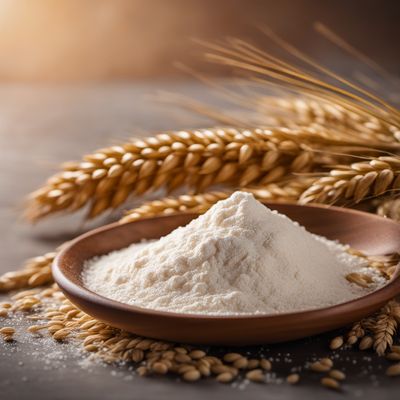
Ingredient
Wheat flour, brown
The Nutrient-Rich Powerhouse: Unveiling the Secrets of Brown Wheat Flour
Brown wheat flour is derived from whole wheat grains, including the bran, germ, and endosperm. It has a slightly coarse texture and a light brown color due to the presence of the bran. This flour is known for its nutty flavor and earthy aroma, which intensify when toasted or baked. It offers a denser and heartier texture compared to refined white flour, making it a popular choice for whole grain bread, muffins, cookies, and other baked goods. Brown wheat flour is also used as a thickening agent in sauces, gravies, and soups.
Origins and history
Wheat has been cultivated for thousands of years and is believed to have originated in the Fertile Crescent region of the Middle East. Brown wheat flour, also known as whole wheat flour, has been a staple in many ancient civilizations, including the Egyptians and Greeks. It was highly valued for its nutritional content and was often used to make bread, a dietary staple in many cultures.
Nutritional information
Brown wheat flour is a nutritional powerhouse, rich in fiber, vitamins, and minerals. It is an excellent source of dietary fiber, providing roughage for a healthy digestive system. It also contains essential nutrients such as iron, magnesium, and B vitamins. One cup of brown wheat flour contains approximately 407 calories.
Allergens
Wheat flour, including brown wheat flour, contains gluten, making it unsuitable for individuals with gluten intolerance or celiac disease.
How to select
When selecting brown wheat flour, look for a reputable brand that offers high-quality whole wheat flour. Check the packaging for any signs of damage or moisture. Opt for flour that has a fresh, pleasant aroma and a uniform texture. Avoid flour that appears clumpy or has a rancid smell.
Storage recommendations
To maintain the freshness and quality of brown wheat flour, store it in an airtight container in a cool, dry place. It is best to use it within 6 months to a year to ensure optimal flavor and nutritional value.
How to produce
Brown wheat flour is typically produced by milling whole wheat grains, including the bran, germ, and endosperm. This can be done using a home grain mill or by purchasing pre-milled whole wheat flour.
Preparation tips
When using brown wheat flour in baking, it is important to note that its higher fiber content may require additional moisture in the recipe. It is recommended to combine it with other flours or use it in recipes specifically designed for whole wheat flour. To enhance the nutty flavor, toast the flour lightly before incorporating it into your recipes. Additionally, sifting the flour can help remove any larger particles and improve the texture of your baked goods.
Substitutions
Whole wheat flour can be used as a substitute for brown wheat flour. However, keep in mind that the texture and flavor may differ slightly.
Culinary uses
Brown wheat flour is commonly used in baking, particularly for whole grain bread, muffins, pancakes, and cookies. It adds a rich, nutty flavor and a hearty texture to these baked goods. It can also be used as a thickening agent in sauces, gravies, and soups.
Availability
Brown wheat flour is widely available in grocery stores, supermarkets, and health food stores worldwide.
More ingredients from this category

Wheat flour, durum
Versatile Grain Powerhouse

Chapatti flour
The Versatile Flour for Perfect Indian Flatbreads

Wheat flour white
The Versatile Flour: Unleashing the Power of White Wheat Flour

Wheat wholemeal flour
Nutrient-Rich Whole Grain Flour

Graham flour
The Wholesome Wonder: Unveiling the Secrets of Graham Flour